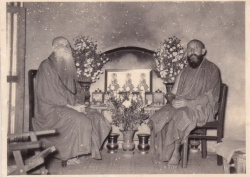The Beginning of Buddhism in Estonia: Friedrich Lustig
Voldemar Friedrich Lustig, the second Buddhist in Estonian Buddhist history, was born on 26 April 1912. Lustig graduated from Narva Gymnasium in 1927 and his first poem was published in a Narva newspaper the same year. While giving lectures on Buddhism in Narva, Tõnisson met Lustig, who became his disciple and companion till the end of his life.
In 1931, Tõnisson and Lustig started their journey by foot through Europe to Asia, hoping to go to Tibet, and in 1935–1936 they spent a year and a half in China. During the Second World War they stayed in Thai monasteries. In 1941, Tõnisson and Lustig openly criticised the politics of the Thai government in local newspapers because of Thailand's support of Japan, and the renaming of Siam as Thailand, which they took as backing away from Siam's Buddhist cultural heritage. In 1949, the Thai government exiled Estonian monks to Burma.
Tõnisson and Lustig settled in Rangoon, where later Lustig became the head of a Rangoon library. In Burma, Lustig was also known as a Buddhist poet and he translated poetry from local languages into English. Tõnisson and his disciple spent their last days in Rangoon among Buddhist monks who belonged to the Hinayana tradition, although they both belonged to the Mahayana tradition.
In 1956, Tõnisson and Lustig participated in the Fourth International Buddhist Conference in Kathmandu in Nepal, and they came into contact with lamas from Buryatia, who for the first time had left Buryatia.
Tõnisson died on 9 May 1962 in Burma, where he was seen as a holy man. After his death, he was proclaimed a Bodhisattva - an honour that is very rare in Hinayana Buddhism.
So Estonians got their first religious saint, their own Bodhisattva. Until their death, Tõnisson and Lustig were officially the representatives of Baltic Buddhists to the Western world, as the 13th Dalai Lama had named Tõnisson the first Buddhist Archbishop of Estonia, Latvia and Lithuania. As Estonia was occupied by the Soviet Union, they could not maintain contact with people in their homeland, and there were no other Buddhists in Estonia, as all religious activity was officially forbidden. On 4 April 1989 Lustig died in Rangoon.
